Binocular Parts and Their Functions-The Ultimate Guide!
You use binoculars for seeing distant objects, A safari expedition to Africa, your next cruise adventure or your next bird watching trip could not be interesting without a pair of binoculars but some tech enthusiast always wonders about what are the parts of a binocular and, what are their functions?
Here we try to mention the different parts and elaborate on their functions.
So basically Binocular consists of below-mentioned components;
Binocular Parts
a. Objective Lens-Catches the light first emitted from the distant object.
b. Prism( Porro & Roof Prism Type)-Corrects the inverted Image through the lenses to the original position of the object
c. Eyepiece/Ocular Lens– Presents the final image to the eyes.
d. Casing/Binoculars Barrel– Provides a covering and fits the different binocular parts together.
e. Diopter– Viewing customization for different eyesights
f. Focus Wheel– Focus adjustment of the Binoculars for objects at different distances.
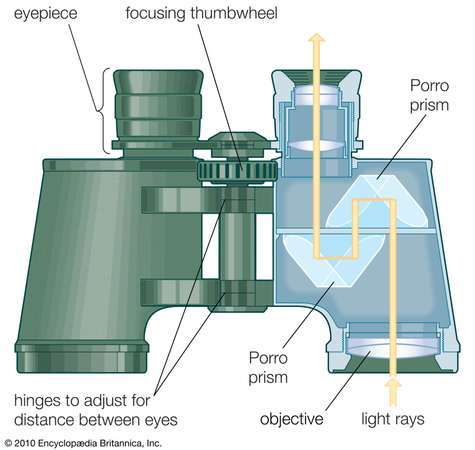
Here we explain in detail about the different binocular parts.
So, Lets us move on to the different components in detail;
1. Objective Lenses
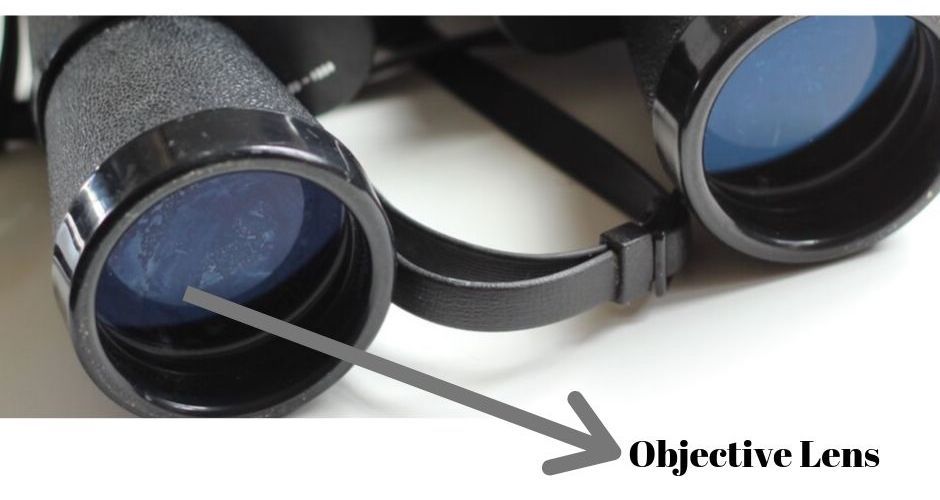
Objective lenses in a Binoculars are nearest to object you are seeing at or in other words they are the farthest from your eyes.
I mean obviously, the binoculars are far from the object that is why you have chosen to look at it through binoculars, but objective pieces are the lenses that catch the ray of light first emitted from the distant object and this is their primary function.
A larger lens diameter means a larger aperture and hence catching more light. If you are a hunting enthusiast or a safari guy a larger lens is your go-to choice.
Can you guess what is the objective lens diameter in the specification 10X42?
If you can’t guess read the answer in my below post:
Read More: What do the numbers on binoculars mean.
Objective pieces are made of glass and are coated with an anti-reflective coating for the maximum catchment of light rays( For a clear view of the object and maximum contrast)
2. Prism Pairs(Roof Prisms/Porro Prisms)
When you look through the binoculars, the object appears Just magnified and the same, although the lenses flip the distant objects, upside down.
Why is this case here?
Here come our savior boys, and we call them binocular Prisms.
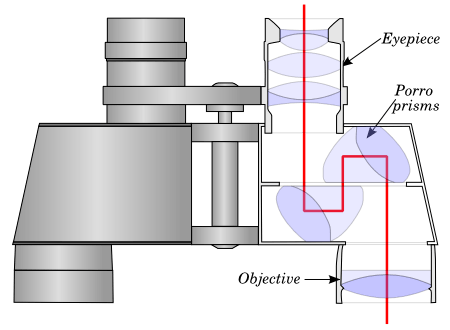
Source: https://commons.wikimedia.org/wiki/File:Binocularp.svg
They are large structural wedges of glass and are in pair.
One prism flips the object by 90 degrees and another again by 90 degrees thus making a total of 180 degrees correcting the upside-down image created by the lenses.
Without the prism, the white pelicans you see in the sky through binoculars would look upside down and backward.
Sometimes you feel why my binos are heavy and meaty in the middle, this is due to the prisms are located there.
Prism comes in two arrangements Roof Prisma and Porro Prism arrangement
Porro prism is set up at 90 degrees to each other while roof prisms are fitted with a back to back arrangement.
Also Read: How do binoculars work
The prism also folds the light path so that the binoculars don’t become too long and bulky and thus can be handled by a human hand.
Practically, its easy to differentiate, If the objective lens and ocular lens(eyepiece) are in line they are roof prism binoculars However If both are are offset from each other the design is a pro prism design
3. Eyepiece/Ocular Lens
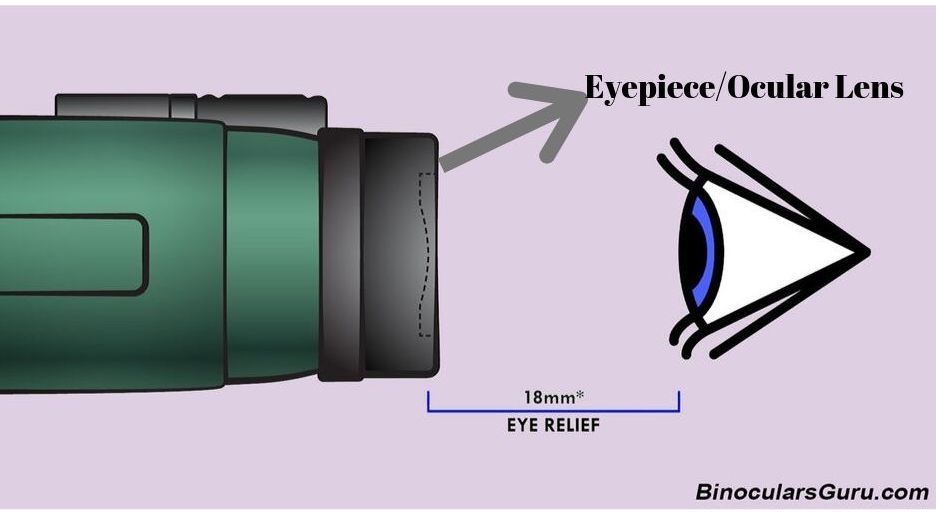
The eyepiece lens as clear from the terminology is nearest to the eyes while looking at the distant object.
When you are looking from your binoculars, these are the lenses you are looking directly into.
Simply speaking, The objective lens creates an image and the eyepiece magnifies the image and presents the enlarged image to your eager eyes waiting to catch up that spot on a panther or your sky gazing adventure.
The eyepiece is placed near the focal point of the objective lens.
The eyepieces of binoculars are usually fixed and have a fixed field of view and magnification.
Also, The magnification created by eyepiece depends on the focal length of the eyepiece.
The eyepiece is a collection of lenses and is cased in a housing. To focus the object clearly It can be moved farther and nearer to the objective lens through a thumbwheel which we discuss below.
4. Thumbwheel/Focus Wheel
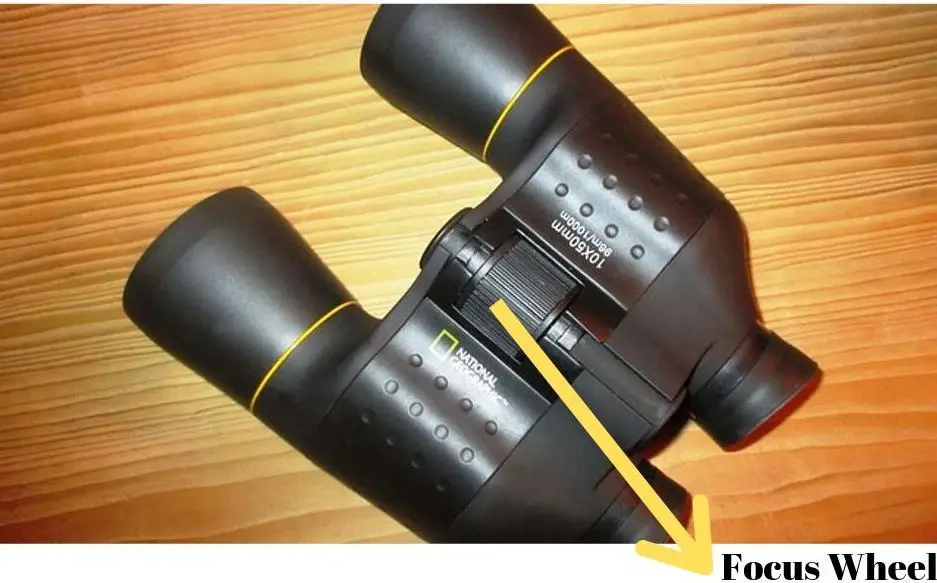
With binoculars, Sometimes you view your favourite birds and sometimes you are into stargazing.
So, How you are able to focus on two objects which are clearly at different distances from you.
Here comes the focus wheel into action.
Simply speaking, It’s important to get a sharp and clear view of the object which is at different distances from you, this is achieved by adjusting the focus of the binoculars by rotating the thumbwheel.
The rotation changes the distance between the eyepiece and objective lens making the focal point of the eyepiece match the focal point of the objective lens
5. Binoculars Barrel
So, how on the earth the binocular eyepiece lenses, objective lenses, and prisms are together?
Yes, the answer is the Binoculars two-barrel chambers that fit these parts together and in alignment.
Both the barrels of a binocular need to be optically parallel for the image to merge into one perfect circle.
Also. the two barrels remain aligned with each other no matter what the gap between the pupils of your eyes.
Usually, The binocular housing is covered with Gutta Percha which increases its longevity and also is sometimes coated with a protective rubber coating.
The barrel housing with covering also protects the binoculars from shock and mishandling like accidentally damaging after falling from hands.
6. Diopter Adjustment Knob
Each eyesight is different and when you look through binoculars the difference in an optical system for both eyes can strain your eyes easily.
Sometimes you may see a blurry image and believe your binos are not working right.
Here comes the Diopter adjustment into action which nullifies the exaggeration and increases the viewing comfort and accuracy.
Usually, Diopter adjustment knob is located near one of the eyepieces into the barrel usually marked with +/-.
Diopter adjustment can vary from person and person. Another person using the same binocular need to have a different custom tuning for diopter adjustment.
More Resources: Focus Binoculars With Diopter Adjustment
Summary
So, binoculars consist of a two-barrel chamber, eyepiece lenses, objective lenses, Prisms, diopter knob, and focusing wheel.
The objective lens collects the light from the objects, the eyepiece presents the magnified object to the eye and prisms re-invert the flipped images and lengthens the light.
Diopter knobs make the binoculars suitable for different eyesights and the focusing wheel brings the image into focus
Barrels serve as protective casing all parts fit into alignment in the Binoculars barrel.
Hope you have understood well, the different parts of a binocular and how do they work.
If you are interested in buying a pair of binoculars check our reviews of

Please can you tell me what the little dial between the eyepiece lenses is for and what it should be set at? It has a few lines on it and the numbers 60 and 70; there is a white dot beside the right hand lens that the numbers could line up with
Is this good for science class?
Inherited a Scope model 2833. Right eyepiece is missing. Anyone have one for sale? Or a pair? Or a different pair that fit? Will pay American money.